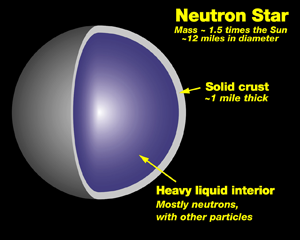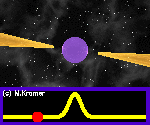WARNING: This website is obsolete! Please follow this link to get to the new Einstein@Home website!
The Einstein@Home Arecibo Radio Pulsar search: Topic 1 |
|
What is a radio pulsar? |
[home] [next] |
||||
|
When a massive star uses up all its nuclear fuel for energy production, it collapses under its own weight. The core of the star gets compressed so much that the protons and electrons within it combine to become neutrons. The resulting object is called a neutron star. (If the neutron star weighs more than two or three solar masses, it collapses further and forms a black hole.) Radio pulsars are neutron stars with an immensely strong magnetic field. They rotate and accelerate electrons in their vicinity to close to the speed of light. These electrons emit polarized light (called coherent curvature radiation) in a narrow cone. When this cone sweeps across the line of sight to Earth, we see the radio emission brighten regularly, just like a lighthouse. Some radio pulsars are also seen in visible light, X- and gamma rays. So far, pulsars have been the primary way that neutron stars can be observed. About 1800 of them are known today. Only a tiny fraction of pulsars is in binary systems where their masses can be determined. The known sample is not large enough to determine a firm upper mass limit, which would in turn give more detailed insight into the physics of such extremely dense forms of matter.
All Pulsars in a CatalogueBrowse the ATNF online pulsar catalogue that contains the most recent information on the 1800 known pulsars. |
|
Last updated on 10 June 2009
This material is based upon work supported by the National Science Foundation (NSF) under Grants PHY-1104902, PHY-1104617 and PHY-1105572 and by the Max Planck Gesellschaft (MPG). Any opinions, findings, and conclusions or recommendations expressed in this material are those of the investigators and do not necessarily reflect the views of the NSF or the MPG.
Copyright © 2025 Einstein@Home

